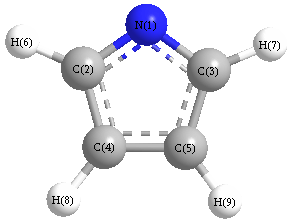Vibrational Frequencies calculated at CCD/cc-pVTZ
| Mode Number |
Symmetry |
Frequency
(cm-1) |
Scaled Frequency
(cm-1) |
IR Intensities
(km mol-1) |
Raman Act
(Å4/u) |
Dep P |
Dep U |
|---|
| 1 |
A1 |
3295 |
3077 |
0.76 |
|
|
|
| 2 |
A1 |
3253 |
3037 |
0.58 |
|
|
|
| 3 |
A1 |
1611 |
1504 |
6.96 |
|
|
|
| 4 |
A1 |
1492 |
1393 |
26.36 |
|
|
|
| 5 |
A1 |
1256 |
1172 |
5.31 |
|
|
|
| 6 |
A1 |
1118 |
1044 |
38.13 |
|
|
|
| 7 |
A1 |
1072 |
1001 |
0.02 |
|
|
|
| 8 |
A1 |
902 |
842 |
12.14 |
|
|
|
| 9 |
A2 |
941 |
879 |
0.00 |
|
|
|
| 10 |
A2 |
894 |
835 |
0.00 |
|
|
|
| 11 |
A2 |
526 |
491 |
0.00 |
|
|
|
| 12 |
B1 |
902 |
843 |
0.01 |
|
|
|
| 13 |
B1 |
739 |
690 |
66.86 |
|
|
|
| 14 |
B1 |
575 |
537 |
22.15 |
|
|
|
| 15 |
B2 |
5048 |
4713 |
89390.71 |
|
|
|
| 16 |
B2 |
3268 |
3051 |
74.95 |
|
|
|
| 17 |
B2 |
3243 |
3028 |
163.63 |
|
|
|
| 18 |
B2 |
1341 |
1252 |
101.37 |
|
|
|
| 19 |
B2 |
1310 |
1223 |
61.66 |
|
|
|
| 20 |
B2 |
1037 |
969 |
0.59 |
|
|
|
| 21 |
B2 |
897 |
838 |
2.20 |
|
|
|
Unscaled Zero Point Vibrational Energy (zpe) 17359.7 cm
-1
Scaled (by 0.9337) Zero Point Vibrational Energy (zpe) 16208.8 cm
-1
See section
III.C.1 List or set vibrational scaling factors
to change the scale factors used here.
See section
III.C.2
Calculate a vibrational scaling factor for a given set of molecules
to determine the least squares best scaling factor.
